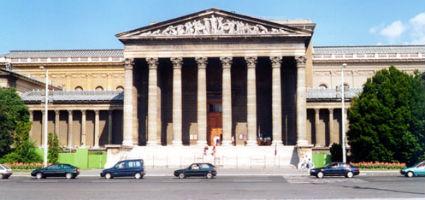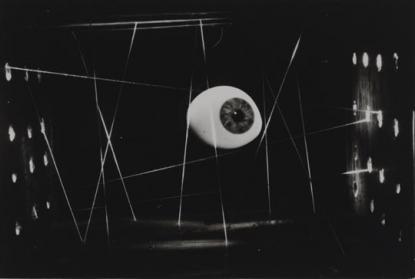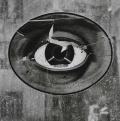2024. April 20. Saturday
Budapest Museum of Fine Arts - Budapest
 |
Address: 1146, Budapest Dózsa György út 41.
Phone number: (1) 469-7100
E-mail: info@szepmuveszeti.hu
Opening hours: Tue-Sun 10:00-18:00
|
The exhibition has closed for visitors.
2012.09.06. - 2012.11.11.
Museum tickets, service costs:
|
Ticket for adults
(valid for the permanent exhibitions)
|
2800 HUF
|
/ capita
|
|
Ticket for adults
|
3200 HUF
|
|
|
Group ticket for adults
|
2900 HUF
|
|
|
Ticket for students
(valid for the permanent exhibitions)
|
1400 HUF
|
/ capita
|
|
Ticket for students
|
1600 HUF
|
|
|
Group ticket for students
|
1400 HUF
|
|
|
Ticket for pensioners
(valid for the permanent exhibitions)
|
1400 HUF
|
/ capita
|
|
Audio guide
|
800 HUF
|
|
|
Video
|
1000 HUF
|
The all-round American photographer Nathan Lerner (1913-1997), known also as a painter and applied artist, was one of the key figures of Chicago's visual arts scene in the last century. He studied at the New Bauhaus in Chicago (later School of Design, then Institute of Design), which, founded in 1937, was the first place in the United States to provide systematic education in design.

Besides director László Moholy-Nagy, his mentor was another Hungarian, György Kepes, who taught him photography. It was following their guidance that Lerner mastered the language of "new vision". He arrived at his invention, the so-called "light box", through experiments conducted at the school. Its basic principle was the seemingly evident realization that the lens of the camera can function as an aid in perfecting the picture we form of the world. By cutting small holes into the side of a box made of black paper he was able to determine the path of light. His first abstract photographs were made with the help of this device. Lerner, working as Kepes' assistant from 1939 and independently as professor of the school from 1941, identified the style of his own work as "natural surrealism".
From the beginning of the 1930s the eye as an instrument of vision became a recurring element in his art. The exhibition attempts to demonstrate the interest Lerner had throughout his body of work in this iconographic motif. The eye-motif, often recalling bizarre and enigmatic associations, appears in his pictures in the most varied and unexpected situations. The montages, which are frequently charged with the politics of the time, - made without scissors by enlarging several photos in one or through the manipulation of negatives - attest to insightful psychological awareness. Lerner's metaphoric straight photography examining the relation of people and the city and capturing carefully selected details of urban environment on the other hand suggest a natural and spontaneous outlook on the world.
His sensitivity towards the act of seeing is rooted in an art philosophy aimed at "eye training". This sensory organ which played the greatest part in Lerner's perception of quality was of good service to him even in his last years. It was through Lerner that the work of Henry Darger - since become one of the best-known "outsider artists" - was discovered.
The show fits into the series of dossier exhibitions of the Collection of Art After 1800. The works presented were donated by the artist's widow, the Chicago-based pianist Kiyoko Lerner, to the Museum of Fine Arts' Photographic and Media Collection set up in 2010.

Besides director László Moholy-Nagy, his mentor was another Hungarian, György Kepes, who taught him photography. It was following their guidance that Lerner mastered the language of "new vision". He arrived at his invention, the so-called "light box", through experiments conducted at the school. Its basic principle was the seemingly evident realization that the lens of the camera can function as an aid in perfecting the picture we form of the world. By cutting small holes into the side of a box made of black paper he was able to determine the path of light. His first abstract photographs were made with the help of this device. Lerner, working as Kepes' assistant from 1939 and independently as professor of the school from 1941, identified the style of his own work as "natural surrealism".
From the beginning of the 1930s the eye as an instrument of vision became a recurring element in his art. The exhibition attempts to demonstrate the interest Lerner had throughout his body of work in this iconographic motif. The eye-motif, often recalling bizarre and enigmatic associations, appears in his pictures in the most varied and unexpected situations. The montages, which are frequently charged with the politics of the time, - made without scissors by enlarging several photos in one or through the manipulation of negatives - attest to insightful psychological awareness. Lerner's metaphoric straight photography examining the relation of people and the city and capturing carefully selected details of urban environment on the other hand suggest a natural and spontaneous outlook on the world.
His sensitivity towards the act of seeing is rooted in an art philosophy aimed at "eye training". This sensory organ which played the greatest part in Lerner's perception of quality was of good service to him even in his last years. It was through Lerner that the work of Henry Darger - since become one of the best-known "outsider artists" - was discovered.
The show fits into the series of dossier exhibitions of the Collection of Art After 1800. The works presented were donated by the artist's widow, the Chicago-based pianist Kiyoko Lerner, to the Museum of Fine Arts' Photographic and Media Collection set up in 2010.

